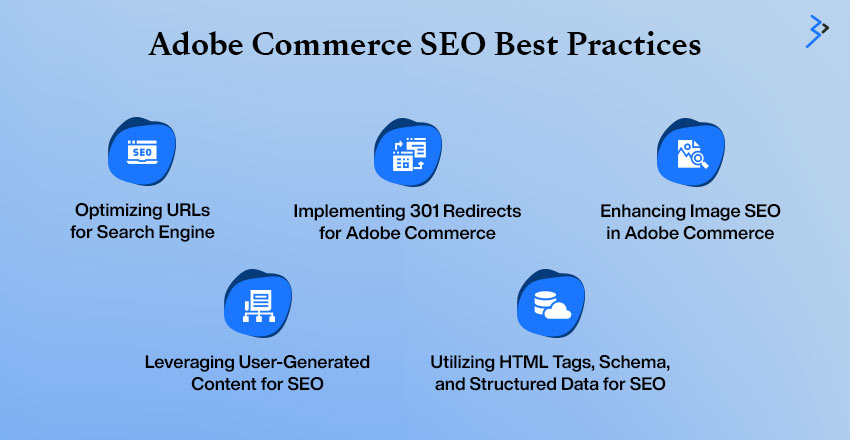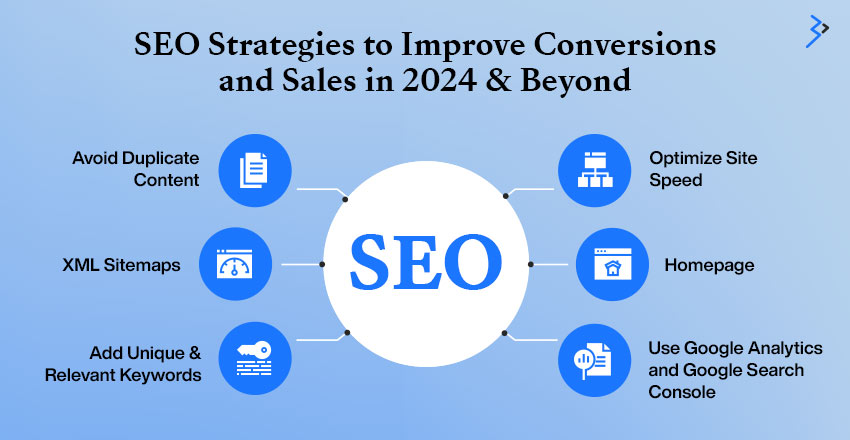Summary
SEO is a game changer for eCommerce businesses that plan to expand their operations!
It’s a crucial factor that allows businesses to expand their traffic and improve sales by targeting the audience interested in buying their products. Stats suggest that over 23.6% of online sales correlate with a website’s organic traffic.
This highlights the importance of investing in a solid Adobe Commerce SEO. Optimizing your website for better visibility allows more people to find you and attract visitors interested in your products or services.
However, since eCommerce growth continues challenging budding and existing businesses, this blog closely examines some SEO strategies. So continue reading as we learn more about SEO in eCommerce and some strategies that could help you boost conversions. Let’s get started!

What is SEO in eCommerce?
eCommerce SEO and regular website SEO have similar underlying ideas but differ dramatically. Both techniques take different approaches and are tailored to a site’s specific structure and purpose.
In simple words, eCommerce SEO is sales-driven, concentrating on optimizing your store to be discovered by your ideal clients and increase the chances of purchase. On the contrary, general SEO spans a wider area and caters to different business goals.
Now that you have a basic idea of eCommerce, let’s look at the core factors of this SEO approach.
Emphasis on Conversion-Driven Pages
eCommerce SEO primarily focuses on the Category and Home pages for individual products to increase sales. For instance, an online fashion retailer optimizes these pages for seasonal trends and specific product lines (“summer dresses” or “men’s sneakers”) to direct visitors to make purchases.
However, things are different for non-eCommerce websites like blogs, educational sites, service providers, or corporate websites. Here, the SEO approach is focused on broader goals such as authority development, content engagement, and lead generation.
The eCommerce SEO site structure is built to streamline user experience. It’s focused on improving UI/UX to drive sales. The hierarchy is divided into products and subcategories, allowing users to filter from broad interests to particular products in a few clicks.
This strategy reduces the number of clicks users need to go to a product page from the homepage. This three-click experience is a part of technical SEO that improves the shopping experience and boosts the possibility of conversion. It’s about giving people a simple, seamless way to browse and purchase things.
Keyword Strategy
eCommerce SEO combines high-intent purchase keywords (“buy vegan leather jacket online”) and informative keywords to target customers at different stages of their purchase journey. This method ensures that an online fashion business attracts ready-to-buy customers and those researching the product.
Dual Focus on SEO and Conversion Optimization
eCommerce SEO focuses on generating visitors and turning them into customers. Every product page element (from SEO-friendly names and descriptions to high-quality photos and appealing CTAs) is designed to encourage visitors to purchase a specific product.
The twin purpose is to guarantee that sites rank well for relevant inquiries while also convincing users to execute a purchase when they arrive. The emphasis is on direct sales conversion, and SEO is used to promote targeted visitors.
Read More: Top 15 Generative AI-powered SEO Platforms
Structured Data Usage
eCommerce websites leverage structured data by applying certain schemas, such as those for products, deals, and reviews, to make their stuff more accessible and appealing in search engine results.
This data enables the display of essential characteristics such as price and ratings directly in the search results. It increases the CTA by providing visitors with real-time information, encouraging them to visit the product page, and adding the product to the cart.
Adobe Commerce SEO Best Practices

Now that we know the core basics of eCommerce SEO let’s uncover some best practices you can implement to increase the sales of your Adobe Commerce store.
1. Optimizing URLs for Search Engine
Adobe Commerce gives you total control over your URL structure, critical to attracting long-term traffic to your business. Optimizing URLs is essential in eCommerce for various reasons:
The URL structure reflects the site hierarchy. A well-organized URL, such as www.example.com/category/subcategory/product, clearly illustrates the relationship between pages, giving search engines a better idea of your site’s structure. This clarity can increase your site’s exposure in search results, making it more straightforward for customers to locate what they need. Navigation and User
Experience: Logical URL architectures help users discover goods more effectively, which improves their purchasing experience.
When crafting your URL structure, keep these tips in mind:
- Incorporate Keywords: Include essential and descriptive keywords in your URLs. This strategy helps search engines understand your pages’ content, improving your site’s search ranks.
- Keep URLs Clean and Simple: Avoid lengthy, complex URLs with extra session or parameter IDs, which might mislead users and slow down the bots crawling your site. Short, keyword-rich URLs are more accessible for users and search engines to grasp.
- Pro Tip: If your URLs need complicated arguments or session IDs, try using mod_rewrite to redirect visitors to more user-friendly URLs. It improves the user experience and allows search engines to crawl and index your site more effectively.
Read More-: Boost Your SEO Strategy: Top AI-Powered Keyword Research Tools for 2025
2. Implementing 301 Redirects for Adobe Commerce
A 301 redirect tells the search engine that a page was relocated to a new location. For example, if you’re retiring an older version of a product (such as red shoes) and releasing a new one, a 301 redirect can effortlessly transition consumers from the old to the new product page. This helps to keep your site’s search visibility.
How 301 Redirects Benefit SEO:
- Preserve Link Equity: Redirecting visitors to the new page preserves the previous page’s search ranking and authority.
- Updates Search Engines: It notifies search engines to update their indexes, allowing the new page to be noticed and ranked faster.
Remember, you can use your Adobe Commerce store’s redirect management tool to configure 301 redirects.
Here’s how you can use it:
Step 1: The first step is to navigate to the redirect management tool, which you can find by logging into your Adobe Commerce account.
Step 2: For the next step, include a new redirect to your page. You can do this by clicking on your dashboard’s “Add New Redirect” option.
Step 3: Next, it’s time to specify the URLs that you want to target. In this step, you must enter and redirect the existing URL to your new URL.
Step 4: At this stage, you should be able to choose the redirect type to “301” for a permanent redirect.
Step 5: Next, it’s time to set the status to “Permanent” and finalize your redirect.
3. Enhancing Image SEO in Adobe Commerce
Have you ever visited an eCommerce store that you were disappointed to visit? Chances are that the images were taking a long time to load.
Image optimization can assist with this situation. It is the method of compressing picture files without reducing their quality. This can speed up eCommerce websites and improve visitor experience.
An image’s alt and title attributes are the textual descriptions commonly referred to as ‘alt tag’ or ‘alt text’ and are created for SEO purposes. Alt text, specifically, is used by the screen users. It is a short description of an image displayed when it cannot be displayed (e.g., if the image file is broken or the user uses a screen reader). Adding alt text to images can help search engines understand a page’s content and improve the page’s search engine visibility.
The Importance of Alt Text in SEO
Alt text is vital for SEO because it allows search engines to comprehend the context of a picture. Consider an online clothing business. On the product page, there is a picture of a red sneaker.
By including alt text that describes the sneaker as “red,” the business may help search engines realize that the page is about a red sneaker. This may help the page rank higher in search results for red sneaker-related keywords.
Adding Alt Attribute in Adobe Commerce
Adobe eCommerce Store allows you to easily include alt text in images by editing picture attributes in the media library. To accomplish this, take these steps:
- Log in to your Adobe Commerce account and go to the Media Library.
- Find the picture you want to add alt text and click on it to see its attributes.
- In the “Alt Text” area, type a brief image description.
- To update the image’s attributes, click the “Save” button.
4. Leveraging User-Generated Content for SEO
As the name implies, it is the content that customers generate, not the brand. It may include reviews, ratings, photographs, and videos. Reading other customers’ feedback can be quite persuading. Furthermore, user-generated content (UGC) may be shared and distributed via social channels, helping to increase brand visibility.
UGC may boost the quality and relevancy of a website’s content, making it more appealing to users and search engines. Such information increases a website’s reputation and authority, enhancing its search results rating.
UGC may create inbound connections to a website using the following strategy:
- Other websites may link to the website’s UGC material as a reference or resource.
- Users can post reviews on their social sites or profiles, which might result in inbound links.
- UGC may be promoted or highlighted on other websites to help build inbound links.
5. Utilizing HTML Tags, Schema, and Structured Data for SEO
Meta tags, schema, and structured data include hidden messages for search engines. They give additional information about a page that may be hidden from visitors. This allows search engines to more precisely interpret your content and improves your ranking in search results.
Optimizing Meta Titles and Descriptions in Adobe Commerce
Title tags assist search engines in comprehending a webpage’s content. Meta descriptions are not directly employed in Google’s ranking algorithms. Still, they play an essential role in the Adobe Commerce SEO checklist since they influence CTR from search results. Consulting with an Adobe Experience Manager consultant can help optimize these elements effectively, enhancing overall SEO performance.
Page names should be around 65 characters long to prevent getting cut off in SERPs. In comparison, meta descriptions are restricted to 160 characters depending on the average length of search results.
Read More-: 8 Benefits Of Technical SEO For Your Website
SEO Strategies to Improve Conversions and Sales in 2024 & Beyond

Avoid Duplicate Content
Having duplicate content on your website can confuse Google’s bots and flag your website. What’s more? It further results in penalties when Google scans your web pages.
Magento’s default configuration generates multiple URLs for the same content. Similar content makes it difficult to filter and categorize items, and the same product may be added to many categories.
Here are a few methods that you could use to remove duplicate content:
- Colonial tags for categories and goods.
- Use Robot.txt. It instructs search engines not to crawl pages that contain duplicate content.
- Category and product URL suffixes
Avoiding duplicate content can help you improve website and mobile SEO, allowing you to easily improve rankings.
XML Sitemaps
An XML sitemap is intended to help web spiders identify otherwise neglected sites. It aids in notifying search engines of available pages for crawling. As a result, the pages get indexed, increasing site prominence.
Magento sitemaps are configured to index all goods and pictures. You list the website’s URLs and prioritize them for a search engine. Save the sitemap.xml file and update it regularly. You may also use robots.txt to block specific pages from being crawled.
Homepage
Magento provides a default homepage for websites. You should personalize the homepage for your brand and use keywords.
Write meaningful and keyword-oriented title tags for all page title components. Google suggests adding the site name to the end of each page title.
Add Unique & Relevant Keywords
Keywords are specific terms entered into the search engine. Users add them to discover the most relevant page results.
Thorough keyword research for your target audience is essential. It allows you to utilize the exact keywords that your consumers are looking for.
Keywords are also useful for Magento 2 SEO strategies. You may use them to advertise and insert them in relevant adverts.
Use Google Analytics and Google Search Console
You may utilize free tools to improve your SEO approach. Google Analytics allows you to track SEO performance and gain market insights. It consists of bespoke segmentation, high-performing pages, and mobile traffic.
Google Search Console allows you to analyze website traffic and improve your internet presence. You may also use the console to address SEO issues. Agencies also utilize these technologies to improve SEO for Magento 2 websites.
Optimize Site Speed
For mobile searches, Google ranks sites based on their speed. A quick eCommerce website lowers bounce rates.
There are several techniques to increase website speed:
- Reliable Magento Hosting Provider.
- Discover professional ways to increase the speed of your Magento 2 website.
- Use a CDN (Content Delivery Network) and enable browser caching.
- Merge and minify JavaScript and CSS files.
Conclusion
SEO strategies play a crucial role in improving the sales and revenue of your Adobe Commerce Cloud store. However, executing all these strategies alone can be challenging; therefore, it’s best to connect with professionals who can help you with a strategic review of your SEO approach. Connect with our Adobe Commerce Cloud SEO experts at Brainvire today!
Related Articles
-
The Complete Guide To Facebook Marketplace And How It’s Changing The Way We Shop
When was the last time you bought from a physical store? If you look at your daily buying history, over the years, you may find that most of the buying
-
How creating a Buyer Persona makes you better than your Competitors
If you run a digital business related to finance, mobile and wireless, or media and entertainment, it’s critical to profoundly comprehend your clients. Before setting up any promotional strategy you
-
How Online PPC Bidding on Amazon Work in 2023?
Your bid could significantly impact the results of your Amazon advertising campaign. Even well-planned ads that are aptly directed at the niche audience sometimes fail to meet expectations. That’s because




